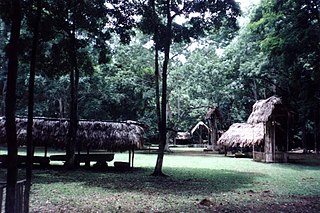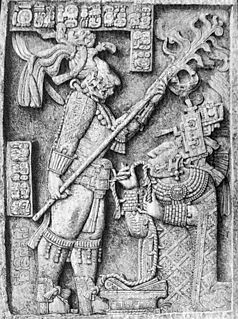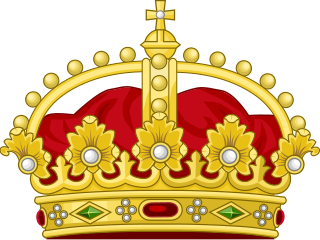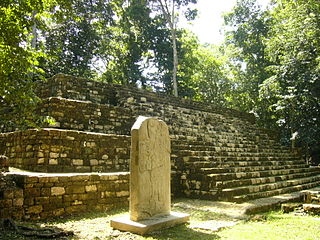
Dos Pilas is a Pre-Columbian site of the Maya civilization located in what is now the department of Petén, Guatemala. It dates to the Late Classic Period, being founded by an offshoot of the dynasty of the great city of Tikal in AD 629 in order to control trade routes in the Petexbatún region, particularly the Pasión River. In AD 648 Dos Pilas broke away from Tikal and became a vassal state of Calakmul, although the first two kings of Dos Pilas continued to use the same emblem glyph that Tikal did. It was a predator state from the beginning, conquering Itzan, Arroyo de Piedra and Tamarindito. Dos Pilas and a nearby city, Aguateca, eventually became the twin capitals of a single ruling dynasty. The kingdom as a whole has been named as the Petexbatun Kingdom, after Lake Petexbatún, a body of water draining into the Pasión River.

Jasaw Chan Kʼawiil I also known as Ruler A, Ah Cacao and Sky Rain,, was an ajaw of the Maya city of Tikal. He took the throne on May 3, 682 and reigned until his death.
B'alam, Balam, Balaam, B'ahlam, Bahlam, Bahlum or Bolom are variant spellings which may refer to:

Itzamnaaj Bʼalam II was a Maya king who ruled in Yaxchilan from 681 until he died in the year 742. He is also called Shield Jaguar II by modern writers and commonly referred to simply as Shield Jaguar based on his name glyph before the phonetic name was deciphered.

Lady Eveningstar was a Maya queen consort, wife of Itzamnaaj Bʼalam II, a Maya king of Yaxchilan. Their son, Yaxun Bʼalam IV - "Bird Jaguar", succeeded his father as king.

Yaxun Bʼalam IV, also called Bird Jaguar IV, was a Mayan king from Yaxchilan. He ruled from 752 until 768 AD, continuing the period of prosperity started by his father Itzamnaaj Bʼalam II. He had to struggle to take and hold power, as he was not perceived to be the rightful heir to the throne.

During the 7th and 8th centuries in Mesoamerica, there was an evident shift in the roles women played in ancient Maya society as compared with the previous two centuries. It was during this time that there was a great deal of political complexity seen both in Maya royal houses as well as in the Maya area. Warfare was a significant factor in political competition and marriage was one of the ways that alliances were made between the different polities. This was accompanied by a shift in women's roles from wife and mother to playing integral parts in courtly life, such as participating in rituals involving the supernatural world and at times ruling individual polities.

Bʼalaj Chan Kʼawiil was a Maya ruler of Dos Pilas. He is also known as Ruler 1, Flint Sky God K and Malah Chan Kʼawil.

Itzamnaaj Kʼawiil was a Mayan king of Dos Pilas. He was the third known ruler of that place. He is also known as the Ruler 2 and Shield God K.

Yichʼaak Bʼalam was a Maya king of Seibal.

Itzamnaaj Bʼalam was a king of Dos Pilas. His reign was short.
Lady of Itzan was a queen of Dos Pilas.
Lady Buluʼ was a Queen of Dos Pilas. She was the wife of Bʼalaj Chan Kʼawiil, the king of Dos Pilas. She was a stepmother of kings Itzamnaaj Bʼalam and Itzamnaaj Kʼawiil.
GI-Kʼawiil (G1-Kʼawiil) was a Queen consort of Dos Pilas. She is also known as the Lady of Cancuén.

Kʼawiil Chan Kʼinich was the last Maya king of Dos Pilas. He is also known as the Ruler 4 and God K Sky Mahkʼina.

Yoʼnal Ahk III, also known as Ruler 5, was an ajaw of Piedras Negras, an ancient Maya settlement in Guatemala. He ruled during the Late Classic Period, from 758 to 767 AD. Yoʼnal Ahk III ascended to the throne upon the death of Itzam Kʼan Ahk II, who may have been Yoʼnal Ahk's father. He was succeeded by his probable brother, Haʼ Kʼin Xook in around 767 AD. Yoʼnal Ahk III left behind two surviving stelae at Piedras Negras, namely Stelae 14 and 16, the former of which has been called one of the finest niche stelae, according to Simon Martin and Nikolai Grube.
Yuknoom Chʼeen II, known as Yuknoom the Great, was a Mayan ruler of the Kaan kingdom, which had its capital at Calakmul during the Classic Period of Mesoamerican chronology.

Yuknoom Yichʼaak Kʼahkʼ ) or Yuknoom Ixquiac was a Maya king of the Kaan kingdom, which had its capital at Calakmul during the Classic Period of Mesoamerican chronology.

Yuknoom Tookʼ Kʼawiil was a Maya ruler of the Kaan kingdom (Calakmul).













